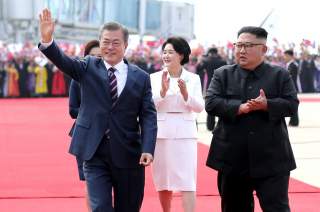The Hanoi Summit – We Asked Sung-han Kim What Happens Next in U.S.-North Korea Relations
"Now, North Korea, after the break-up of the deal, faces two options: complete denuclearization vs. complete nuclear armament."
Editor’s Note: Looking for more opinions on where we go after the Hanoi summit? Check out all 80 expert takes on where U.S-North Korea relations go next here.
At the Hanoi summit President Donald Trump chose “no deal” rather than a “bad deal” that would have traded the closing of the Yongbyon nuclear complex for the lifting of economic sanctions on North Korea. North Korea’s Kim Jong-un made a strategic blunder by pushing Trump too hard by imposing the above “unequal” exchange believing that Trump, who had been politically pinched by Michael Cohen’s testimony overnight, would accept “any” deal as far as it makes the suspension of nuclear and missile testing continue. This miscalculation resulted in Trump’s rejection of the North Korean proposal based on salami-slicing tactics and opened the way for him to propose a “big deal” to Kim Jong-un who could not accept it either.
Now, North Korea, after the break-up of the deal, faces two options: complete denuclearization vs. complete nuclear armament. The probability of “partial denuclearization” based on the series of U.S.-North Korea small deals has been significantly dwindled for North Korea since North Korea’s commitment to denuclearization has thus come to be questioned further after Hanoi. Against this backdrop, we can think of three scenarios in the future: (1) North Korea’s complete denuclearization that starts with the agreement on the roadmap for verifiable denuclearization; (2) back to square one, or “fire and fury” that makes the tension on the Korean Peninsula rise in abrupt manner; and (3) muddling through which means both the United States and North Korea keep negotiating with each other without a dramatic progress while nuclear and missile testing continues to be suspended.
Another gain of the Hanoi summit is that economic sanctions are working on North Korea who put its top priority on the lifting of sanctions while negotiating with the United States in Hanoi. If the United States, China, and South Korea sincerely implement economic sanctions for a while on North Korea, the first scenario is most likely to happen. If North Korea keeps sticking to the strategy that does not go beyond Yongbyon and tries to maximize what it can get from the U.S., however, the second scenario would be more likely. The probability could become even higher if Kim Jong-un relies on the self-fulfilling prophecy that his regime security comes from nuclear weapons and if the South Korean president Moon Jae-in stands on the wrong assumption that inter-Korean reconciliation and cooperation will motivate Kim Jong-un to give up his nuclear weapons. On the other, if Kim Jong-un drags his feet and decides to wait until the next U.S. administration comes in while Trump rapidly moves to the lame-duck, the third scenarios is likely to unfold.
Sung-han Kim is a Dean and Professor of International Relations at the Graduate School of International Studies at Korea University. He previously served as Vice Minister of Foreign Affairs and Trade, Ministry of Foreign Affairs and Trade.
Image: Reuters

